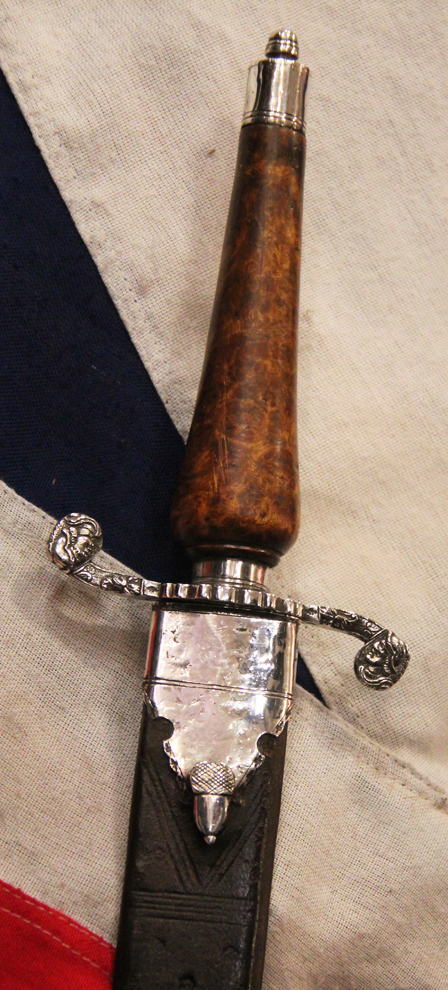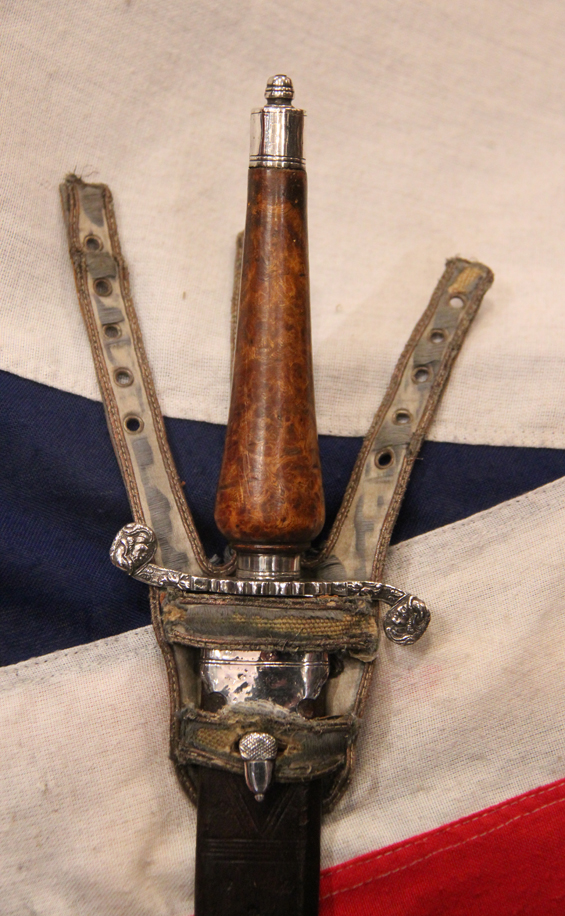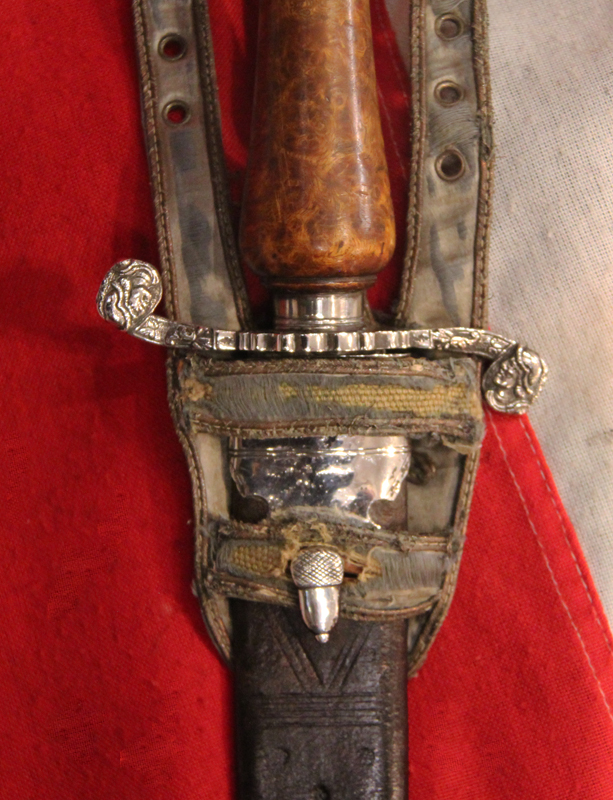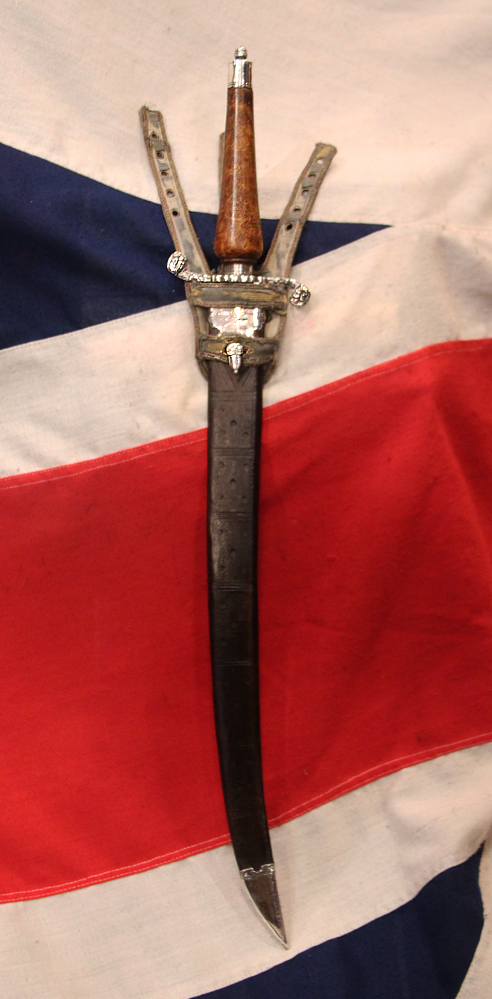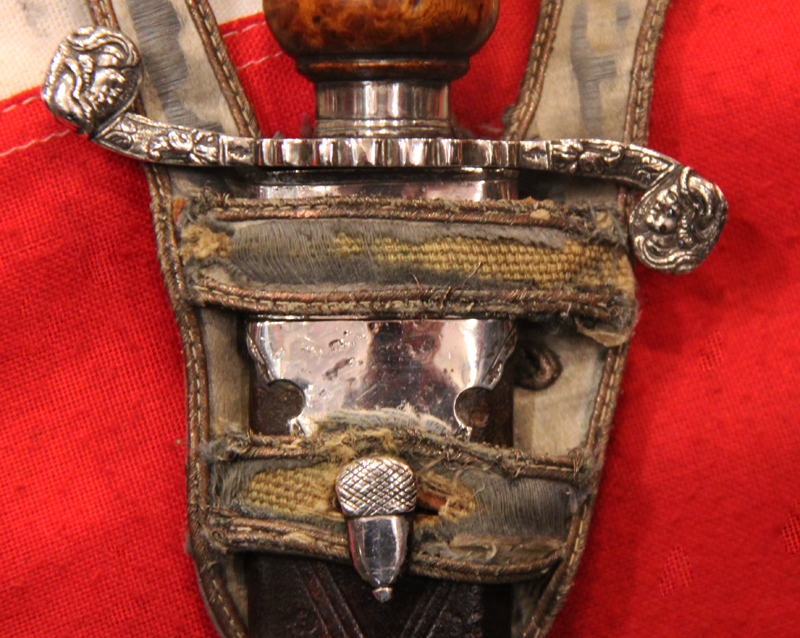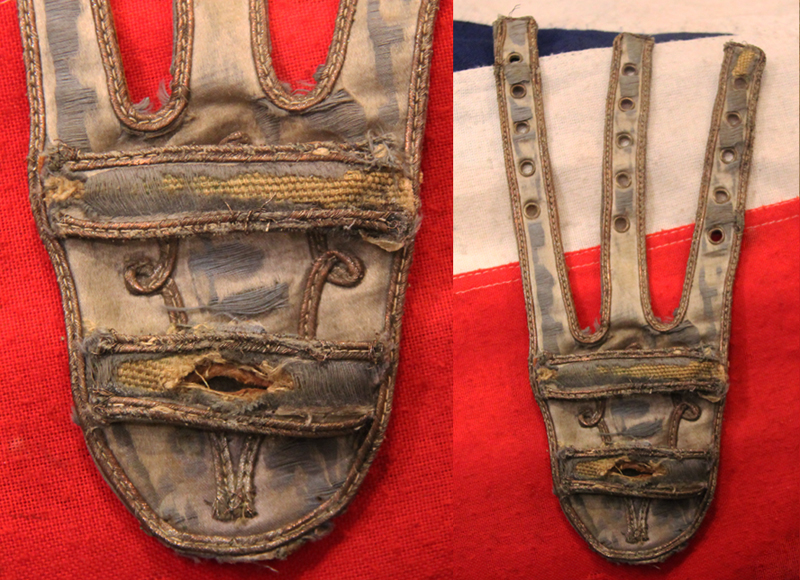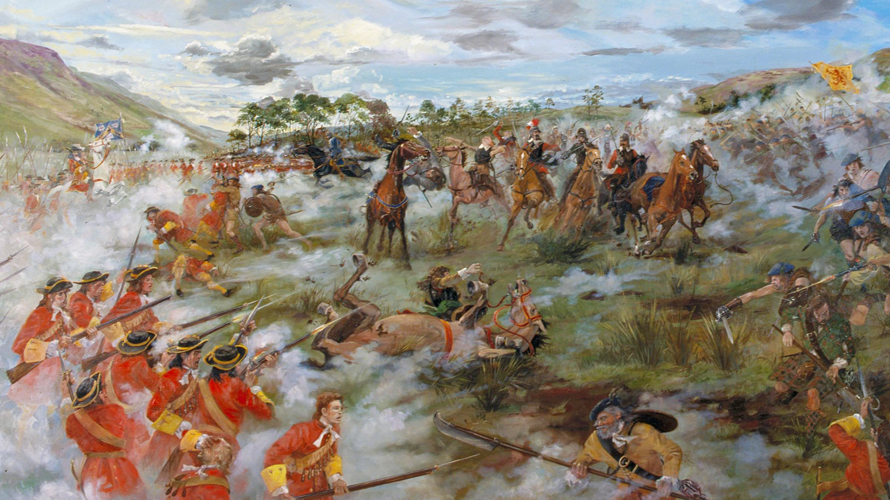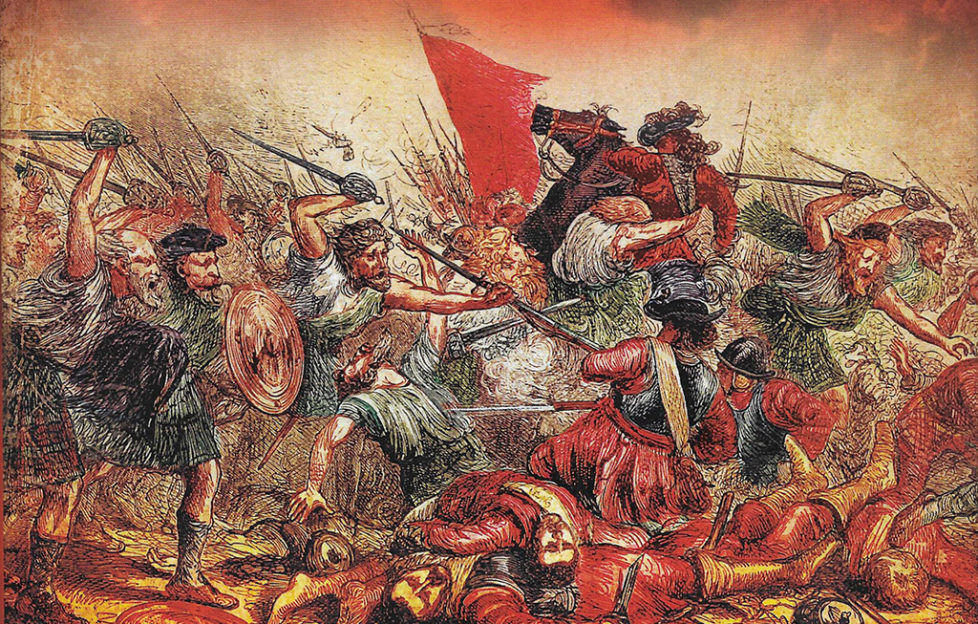Possibly The Finest 17th Cent. French Royal Silver Hunting Short Sword, With Original, Incredibly Rare Scabbard & Belt Mount, From a Royal Collection. With The Rarest Bayonne Form Hilt. Likely Used By The King & His Court For the King’s Boar or Stag Hunt
This is a superb French King Louis XIVth royal hunting all silver mounted short sword, and all silver mounted scabbard, and the sword hilt has a hunting carbine muzzle form bayonne hilt, that can, once fitted into the guns barrel, enable the sword to be used as the very first form of bayonet, that converts a carbine into a long pike or spear. In fact the hilt form was named after the French town of Bayonne, where it was said to have been first used, and thus technically invented, and it is the very first form of bayonet ever made, and whence every future bayonet therefore gets its name. It is fitted within its incredibly rare original silk and silver bullion baldric, and we have never seen another surviving original example of such a fabulous royal baldric outside of Les Invalides Museum in Paris. There may possibly be another in the British {H.M. King Charles IIIrd’s } Royal Collection, as it is likely the largest in the world, but we have never seen it. Silk is one of the worlds strongest natural materials, stronger than steel pound for pound, in fact bullet proof vests were originally made from densely woven silk, but once very old, it becomes fragile and therefore antique silk rarely survives intact, especially such a piece as this.
It further bears in silver bullion decor, stitched into the baldric silk belt ‘frog’ mount, behind the two retaining cross straps, twin, inverted and elongated capital letter ‘L’s’, the personal cypher mark and symbol of King Louis XIVth of France.
The highly distinctive cypher mark of all the King’s of France bearing the name Louis. This may very likely indicate that this sword-bayonet was actually owned and used by the King or within the service of the King of France, by one of his highest ranking officers, or indeed an officer of his personal guard, while in use at the French royal hunting lodge by the king, or his entourage of the Royal Court, for hunting boar or stag.
The hunting sword is only usually used as the ‘coup de grace’ to finish off the beast at the hunts conclusion. However it is also an essential defensive arm to protect the king or a noble if the beast turns upon its hunter, which can be most perilous, and indeed, it is well known to be a most frequent fate of many unfortunate huntsman. The royal hunt since medieval days has been a very dangerous royal sport, with many nobles, princes or even kings meeting their grisly end.
King William II (William Rufus), who reigned in England from 1087 to 1100, was killed by an arrow while hunting in the New Forest on August 2nd, 1100, a death widely suspected to be an assassination rather than a hunting accident
King Christian V died from the after-effects of a hunting accident that occurred on October 19, 1698. Christian was hunting with his two sons and his half-brother.
One of finest quality pieces of its type we have ever had the privilege to own, and incredibly still in its original silver mounted scabbard and silk and silver bullion baldric. Probably this can be seen as the best available within the worldwide collecting market today.
It is also probably the most complete example, from the mid to late 1600's, we have ever seen, certainly in over 40 years, including those we have handled within the Royal Collections. This magnificent hunting short sword with bayonne {bayonet} hilt would be the prize of any of the finest worldwide collections of the rarest short swords that can double as the very rare, so called ‘plug’ bayonet, as they are ‘plugged’ into the muzzle of a musket, to convert it to a pike or spear. It is remarkably complete with its silver bullion and silk baldrick frog belt mount with three tongues. It has finest quality solid silver mounts, with decorated quillons bearing profile heads of possibly the king’s huntsman adorned with hunting caps, very similar to the armourer's marks on the blade. And the silver scabbard mounts and fittings also beautifully match, with an acorn frog mount. The original scabbard leather is superb condition, crosshatch patterned, with the so called ‘bullets and lines’ stamped decor. It has a wonderful blade, in stunning order, with two large matching armourer's marks of a profile head on both blade sides. The grip handle is birds-eye maplewood with a silver pommel.
While en residence at Versailles, at 2 pm: the king, Louis XIVth, gave his orders and announced his plans in the morning. If he went on a walk, it would be in the gardens on foot or in a Barouche with the ladies. If he decided to go hunting, the favourite sport of the Bourbons, the monarch would go to the park if he chose to hunt with weapons, and to the surrounding forest when hunting on horseback.
Since the days of the Pharoahs, hunting has been an essential activity of courts. Hunting was both a pleasure, and a way of gathering game for the royal table. Once one area was hunted out, the court moved on to the next. In many different monarchies hunting became an obsession, with its own music, dress and flamboyant rituals. One Chinese prince said: ‘I would rather not eat for three days than not hunt for one’
Hunting was so important that it could decide where the court resided. The proximity of hunting forests was one reason for the choice, as a royal residence, of Windsor, Versailles, Stupinigi, Hubertusberg, and many other sites. Conversely, the choice of these sites as royal residences ensured that the surrounding forests were well maintained. The landscape of the Ile de France is still dominated by the royal hunting forests of Versailles, Marly, Saint-Germain, Compiegne, Vincennes, Fontainebleau, and Rambouillet.
In addition to the pleasure and food it provided, hunting could also acquire a political and hierarchical function. Hunting was a visible assertion of domination over the land and the animal kingdom. It also protected the ruler’s subjects and their herds from boar, wolves and other vermin. The stag was the noblest beast, hunting it the noblest sport. Furthermore hunting was believed to be a school of war, masculinity and horsmanship. It taught courage, comprehension of landscape, and the art of the cavalry charge. In l’Ecole de Cavalerie of 1751, Robichon de La Guerroniere described hunting:
‘it is the pastime which Kings and Princes prefer to all others. This inclination is no doubt based on the conformity existing between hunting and war. In both, in effect, there is an object to tame’,
The story of the evolution of the bayonne, plug bayonet;
The late 17th century saw the final demise of the pike, and its replacement by the bayonet. The plug bayonet, which blocked the muzzle of the musket and needed to be removed for firing, did not catch on. The earliest military use of bayonets was by the French Army in 1647, at Ypres. These were plug-fitted into the barrel. That prevented firing once they were mounted, but allowed musketeers to act as their own pikemen, which gave infantry formations greater firepower. By 1650 some muskets had bayonets fixed to the gun at manufacture, hinged and foldable back along the barrel. French fusiliers adopted the plug bayonet as standard equipment in 1671; English fusiliers followed suit in 1685. The trouble with firing in successive lines was that it was only practical on a narrow front. In open country, the musketeers could easily be flanked, especially by cavalry. In most battles, the musketeers relied on pikemen to protect them while reloading. Infantry practiced various formations and drills that allowed musketeers to hide behind the pikes while reloading and to take up firing positions as soon as their weapons were ready to use. This system worked pretty well, but it obviously cut down the army’s firepower-sometimes by more than half.
The solution to the problem was to turn the musket into a spear. According to some sources, this was the idea of Sebastien le Prestre de Vauban, the great French military engineer in the armies of Louis XIV. It was a solution at least for soldiers. Hunters in France and Spain had for some time been jamming knives into the muzzles of their muskets for protection against dangerous game. It seems that Bayonne, a French city noted for its cutlery, made a type of hunting knife that was favoured for this use. When the French army adopted this weapon, it was called a ‘bayonet’. The earliest reference to the use of the bayonet is in the memoirs of a French officer who wrote that on one campaign, his men did not carry swords, but knives with handles one foot long and blades of the same length. When needed, the knives could be placed in the muzzles of the guns to turn them into spears. The bayonet proved to be a much more effective defense against cavalry than the sword.
There were some drawbacks to the use of plug bayonets when mounted in muskets, When the bayonet was inserted within in the muzzle of a loaded musket and then fired by accident, the gun might indeed explode. This sort of accident seems to have been much more prevalent among civilians who, unlike soldiers, did not load and fire on command. It was so prevalent that in 1660, Louis XIV had to issue a proclamation forbidding the placing of short sword-daggers in the muzzles of hunting guns.
Two pictures in the gallery are of French royal hunts, note in picture 9 the king is holding aloft his same hunting short sword with its distinctive curved blade, and his mistress armed with a boar spear.
Code: 22160
7950.00 GBP



